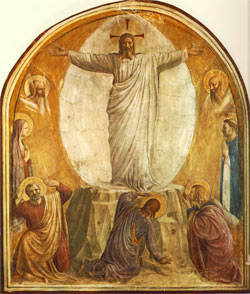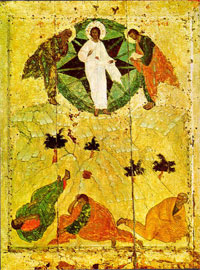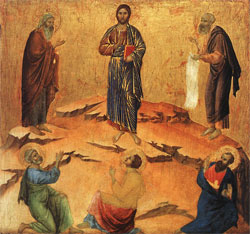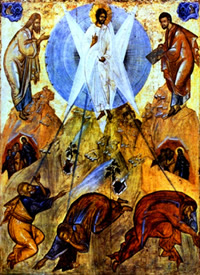From Our Archive
Three essays by Debie Thomas, When Everything Changes (2021); Life on the Threshold (2018) ; and When Seeing Isn't Believing (2015).
This Week's Essay
Mark 9:9, Jesus gave them orders not to tell anyone what they had seen.
For Sunday February 11, 2024
Lectionary Readings (Revised Common Lectionary, Year B)
2 Kings 2:1-12
Psalm 50:1-6
2 Corinthians 4:3-6
Mark 9:2-9
This Sunday is the last week in the short season of Epiphany. The following week we begin forty days of Lent with Ash Wednesday on February 14.
The Greek word for "epiphany" means disclosure, manifestation, unveiling or appearance. So, how appropriate that Mark 9:2–9 for this week describes one of the greatest "epiphanies" ever — the transfiguration of Jesus, complete with blinding light, a heavenly voice, and visions of Moses and Elijah.
And, just as with another startling epiphany or disclosure — Peter's confession of Jesus as the Messiah just a few paragraphs earlier in Mark 8, how strange that the transfiguration concludes in all three synoptic gospels with a command of secrecy: "Jesus gave them orders not to tell anyone what they had seen seen." What's the purpose of an epiphany if you are sternly warned to keep it a secret?
 |
|
Transfiguration, Fra Angelico, Italy (1400–1455).
|
Keeping that secret didn't last long. In fact, the "transfiguration" (Greek, metamorphosis) of Jesus became so central to the gospel tradition that all three synoptic writers include it (Matthew 17:1–8 = Mark 9:2–10 = Luke 9:28–36):
After six days Jesus took Peter, James, and John with him and led them up a high mountain, where they were all alone. There he was transfigured before them. His clothes became dazzling white, whiter than anyone in the world could bleach them. And there appeared before them Elijah and Moses, who were talking with Jesus. Peter said to Jesus, "Rabbi, it is good for us to be here. Let us put up three shelters — one for you, one for Moses and one for Elijah." (He did not know what to say they were so frightened). Then a cloud appeared and enveloped them, and a voice came from the cloud: "This is my Son, whom I love, listen to him!" Suddenly, when they looked around, they no longer saw anyone with them except Jesus. As they were coming down the mountain, Jesus gave them orders not to tell anyone what they had seen until the Son of Man had risen from the dead. They kept the matter to themselves, discussing what "rising from the dead" meant.
And later still, about thirty years after the gospels were written, the author of 2 Peter still appealed to the transfiguration to support the authenticity of their message.
What should we make of such a strange story? What are we reading here? A fable, a myth, or some theological metaphor? Eyewitness history? Or maybe some combination of these genres? Does it foretell in some strange way the blinding light and overwhelming sense of peace, calm, and joy that many people report with near death experiences?
 |
|
Transfiguration, Andrei Rublev, Russia (1405).
|
Some will dismiss the transfiguration as a bizarre fiction — as if we enlightened people of today know better than those gullible people two thousand years ago. CS Lewis characterized this sort of outlook as chronological snobbery — “the uncritical acceptance of the intellectual climate of our own age and the assumption that whatever has gone out of date is on that count discredited.” We shouldn't be so smug or self-congratulatory.
Nonetheless, this sort of dismissive incredulity enjoys an ancient pedigree. Consider three examples.
In his Life of Nero, Suetonius (75–160) derided Christians as "a set of men adhering to a novel and mischievous superstition." In his Annals, Tacitus (c. 60–120) sneered at the "pernicious superstitions" of believers.
For Pliny the Younger (62–113), governor of Pontus-Bithynia (modern Turkey) from 111–113, Christians under his rule posed a practical problem. In two famous letters to the emperor Trajan he expressed frustration about how to prosecute believers: "I judged it so much the more necessary to extract the real truth, with the assistance of torture, from two female slaves, who were styled deaconesses, but I could discover nothing more than depraved and excessive superstition."
It's true that people two millennia ago had a world view that's different from ours, but that doesn't mean that they were inherently more credulous than we are today. Just try to imagine how people two millennia from now will judge our own world view today.
I find it hard to believe that the evangelists would propagate a story that they knew was false, knowing that a ludicrous claim would harm their cause, and that making outrageous claims would earn them social ridicule, cultural marginalization, and even physical persecution. The disciples would have been wrong to deny an experience that they had, no matter how difficult it was to comprehend and explain.
 |
|
Transfiguration: Duccio di Buoninsegna, Italy (1308–1311).
|
Decades after the transfiguration, 2 Peter appealed to their terrifying experience precisely to rebut criticisms that the early believers followed "cleverly invented stories." No, he says, they were "eyewitness" accounts of actual events (2 Peter 1:16–18), even if the story, like so many stories in the gospels, was easier to describe than to explain.
A different reading tries to have its critical cake and eat it, too. It purges the story of offensive elements while retaining some kernel of truth — for example, interpreting the transfiguration as an embellished tale, as a truth communicated by myth or metaphor, or even as a misplaced and reinterpreted account of the resurrection.
But this strategy comes at a cost. Its tendency, as history has shown, has been to make the ancient story look and sound conspicuously like the modern critic. And at any rate, what do you end up with but Jesus as a mere humanitarian moralizer or rebel rabbi?
Even if the nature of the transfiguration is not obvious, the gospel writers seem to report a genuine experience. Sometimes even the recipient of such an experience is hard-pressed to explain exactly what happened.
Whether Peter, James and John had an ecstatic vision, or whether Jesus was literally if briefly "metamorphosized" before their very eyes, the natural, physical phenomenon of brilliant light was secondary to the supernatural, metaphysical affirmation of the voice from the cloud — this Jesus was not just a clever sage or failed apocalyptic troublemaker. The transfiguration portrays him as God's beloved and specially appointed Son. Having thus experienced a fleeting glimpse of the full and final consummation of all things, the conclusion is inevitable: "Listen to him."
 |
|
Theophanes the Greek, late 14th century.
|
Three marvels accompanied the transfiguration. First, Jesus's clothes radiated blinding light. Matthew compares this radiance to the brilliance of the sun (Matthew 17:2), Mark to super-bleached laundry (Mark 9:3), and Luke to "a flash of lightning" (Luke 9:29). These descriptions evoke comparisons to Moses on Mount Sinai when Yahweh appeared to him in a cloud and consuming fire (Exodus 24).
Paul similarly described his conversion on the road to Damascus as an encounter with blinding light accompanied by a voice from heaven (Acts 22:6, 26:13), which testimony lends an experiential aspect to his declaration that God "dwells in unapproachable light" (1 Timothy 6:16).
Second, Moses and Elijah appeared. In what 2 Peter calls his "majestic glory," Jesus fulfills the law that Moses received, and consummates the end of all things that Elijah was thought to harbinger (Mark 9:11). In the transfiguration, Jesus is more than Moses, and greater than the great Elijah.
Third, the voice of God the Father from a cloud, reminiscent of that voice at his baptism, affirmed what only a few paragraphs earlier in Mark 8 Peter had confessed, that Jesus is God's beloved and specially appointed Son who merits our total allegiance: "Listen to him."
In his book What Jesus Meant, the historian Garry Wills affirms the radically subversive life, teaching, death, and resurrection of Jesus of Nazareth: "He intended to reveal the Father to us, and to show that he is the only-begotten Son of that Father. What he signified is always more challenging than we expect, more outrageous, more egregious." And that's just what the transfiguration does.
Weekly Prayer
Emily Dickinson (1830–1886)
Tell all the Truth but tell it slant —
Success in Circuit lies;
Too bright for mind's infirm intent,
The Truth's superb surprise.As Lightning to the Children eased,
With explanation kind;
The Truth must dazzle gradually,
Or every man be blind.
Dan Clendenin: dan@journeywithjesus.net
Image credits: (1) Web Gallery of Art; (2) Rollins College, (3) Carol Gerten-Jackson; and(4) Auburn University, Russian resources.





